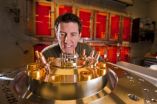(Press-News.org) Researchers at the Institute of Food Research have tested a new technique to ensure fresh produce is free of bacterial contamination.
Plasmas are a mix of highly energetic particles created when gases are excited by an energy source. They can be used to destroy bacteria but as new research shows, some can hide from its effects in the microscopic surface structures of different foods.
Eating fresh fruit and vegetables is promoted as part of a healthy lifestyle, and consumers are responding to this by eating more and in a greater variety. Ensuring fruit and vegetables are free from contamination by food poisoning bacteria is crucial, as they are often eaten raw, without cooking or processing that kills off bacteria.
A move away from current chlorine-based decontamination is driving the search for new, safe ways of ensuring fresh fruit and vegetables are free from bacterial contamination without reducing quality or flavour. One technique being investigated is cold atmospheric gas plasma technology.
Plasmas can effectively inactivate microorganisms, and as they don't involve extreme conditions such as high temperature they have been suggested for use in decontaminating food surfaces without affecting the structure. Dr Arthur Thompson has been investigating how well cold atmospheric plasmas (CAP) inactivate Salmonella under different conditions and on different fresh produce foods at the Institute of Food Research, which is strategically funded by the Biotechnology and Biological Sciences Research Council.
Publishing in the journal Food Microbiology, Dr Thompson found Salmonella could be effectively inactivated by plasmas, but the length of exposure varied greatly depending on the type of produce. Other variables, such as the ambient temperature of the produce or the growth phase of the Salmonella had no significant effect. Inactivation on food surfaces took longer than on an artificial membrane filter surface.
To understand why, the researchers looked at the food surfaces with an electron microscope. At this microscopic level of detail, it was possible to see how Salmonella could 'hide' from the effects of the plasmas. Different structures, such as the bumps on the strawberries, the pores in lettuce leaves or the cell walls of potatoes create shadowed zones that block plasma reaching bacteria.
This study was conducted using a laboratory scale plasma device, used as part of ongoing research at IFR to study operational parameters and investigate precisely how cold plasma's destroy bacteria.
"The results suggest scaled up devices or combinations with other mild treatments could provide a very effective solution for destroying bacteria with little or no effect on the produce itself." said Dr Thompson. "What this study shows is that it will be important to take into account the type of food and its surface structure."
INFORMATION:
Reference: Inactivation of Salmonella enterica serovar Typhimurium on fresh produce by cold atmospheric gas plasma technology, Food Microbiology doi: 10.1016/j.fm.2012.08.007
Assessing a new technique for ensuring fresh produce remains Salmonella-free
2012-09-17
ELSE PRESS RELEASES FROM THIS DATE:
Simple test to predict if pregnant women will give birth prematurely
2012-09-17
Babies born early run a greater risk of serious complications. The researchers at the Sahlgrenska Academy, University of Gothenburg, Sweden, have now developed a method to predict if pregnant women with preterm contractions will give birth within seven days. The method offers new possibilities to delay delivery and prepare care for the premature baby.
Delivery before 37 full weeks, so-called preterm delivery, is the biggest problem in perinatal medicine today, as it increases the risk of the child being seriously ill in the short and long term. The problem is that only ...
Sound level around seriously ill patients 'like a busy road'
2012-09-17
Seriously ill patients in intensive care units are being cared for in environments with sound levels more than 20 dB higher than the WHO's recommendations. This is shown by a study carried out in partnership between the University of Gothenburg and the University of Borås.
In the study, the researchers registered sound levels around 13 seriously ill patients cared for in the intensive care unit at Södra Älvsborg Hospital over a 24-hour period. The study shows that the sound levels around seriously ill patients were on average between 51 and 55 dB. This is comparable ...
Back to school: Is higher education making you fat?
2012-09-17
Ottawa, Canada (September 17, 2012) –A new study published today in the journal Applied Physiology, Nutrition, and Metabolism (APNM) looks beyond the much-feared weight gain common to first-year students and reports on the full 4-year impact of higher education on weight, BMI, and body composition.
"Gropper et al. present a unique study that follows students through their undergraduate years. It documents the nature of the weight gain and shows the differences between males and females," says Susan Whiting, a professor of nutrition and dietetics at the University of ...
AGI releases the new 2012 Critical Needs Document
2012-09-17
Alexandria, VA – With less than two months before Election Day, AGI and its federation of 50 professional geoscience societies have come together again to provide a list of critical issues and policy recommendations for the next presidential administration. The document, Critical Needs for the Twenty-first Century: the Role of the Geosciences, is meant to inform policymakers of the unique knowledge, experience, and ingenuity of the geoscience community, and to address some of society's most pressing issues.
More commonly known as the Critical Needs Document, the new ...
US underestimates costs of carbon pollution and climate change
2012-09-17
The U.S. federal government is significantly underestimating the costs of carbon pollution because it is using a faulty analytical model, according to a new study published in the Journal of Environmental Studies and Sciences.
A more appropriate accounting of costs would pave the way to cleaner, more economically efficient sources of power generation, the study found.
"This is a wake-up call for America to start aggressively investing in low carbon sources of energy. The very real economic benefits will accrue quickly and increase over time," said Dr. Laurie Johnson, ...
Researchers call for early diagnosis of flesh-eating infections
2012-09-17
New Orleans, LA – Dr. Russell Russo, an Orthopedic Surgeon at LSU Health Sciences Center New Orleans, and other researchers stress that orthopedists should have a high index of suspicion for necrotizing fasciitis, or flesh-eating bacterial infection, in every patient with pain or other symptoms that are out of proportion to the initial diagnosis. Their recommendations are published in the September 2012 issue of Orthopedics Today.
Although relatively rare and difficult to diagnose because its symptoms often resemble other conditions like synovitis or cellutitis, a missed ...
When it rains, it pours
2012-09-17
CAMBRIDGE, Mass. — Extreme precipitation in the tropics comes in many forms: thunderstorm complexes, flood-inducing monsoons and wide-sweeping cyclones like the recent Hurricane Isaac.
Global warming is expected to intensify extreme precipitation, but the rate at which it does so in the tropics has remained unclear. Now an MIT study has given an estimate based on model simulations and observations: With every 1 degree Celsius rise in temperature, the study finds, tropical regions will see 10 percent heavier rainfall extremes, with possible impacts for flooding in populous ...
Majority of US Schools not ready for next pandemic, SLU researchers say
2012-09-17
ST. LOUIS – Many U.S. schools are not prepared for bioterrorism attacks, outbreaks of emerging infectious diseases or pandemics, despite the recent 2009 H1N1 influenza pandemic that resulted in more than 18,000 deaths worldwide, Saint Louis University researchers say.
The study, led by Terri Rebmann, Ph.D., associate professor at SLU's Institute for Biosecurity, surveyed about 2000 nurses working in elementary, middle and high schools across 26 states. The findings reveal that only 48 percent of schools address pandemic preparedness and only 40 percent of schools have ...
AGU journal highlights – 17 September 2012
2012-09-17
The following highlights summarize research papers that have been recently published in Geophysical Research Letters (GRL), Journal of Geophysical Research – Solid Earth (JGR-B), Journal of Geophysical Research – Planets (JGR-E), Journal of Geophysical Research – Earth Surface (JGR-F), Journal of Geophysical Research – Biogeosciences (JGR-G).
In this release:
1. Characterizing the surface composition of Mercury
2. African dust forms red soils in Bermuda
3. Sea level controls carbon accumulation in the Everglades
4. Climate change threatens permafrost in soil
5. ...
Dry-run experiments verify key aspect of Sandia nuclear fusion concept
2012-09-17
ALBUQUERQUE, N.M. — Magnetically imploded tubes called liners, intended to help produce controlled nuclear fusion at scientific "break-even" energies or better within the next few years, have functioned successfully in preliminary tests, according to a Sandia research paper accepted for publication by Physical Review Letters (PRL).
To exceed scientific break-even is the most hotly sought-after goal of fusion research, in which the energy released by a fusion reaction is greater than the energy put into it — an achievement that would have extraordinary energy and defense ...


